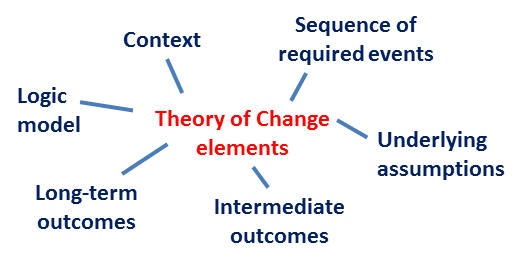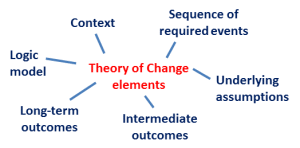Using a theory of change (ToC) to better understand your program
This post provides a short introduction to the language and concepts of Theory of Change or program theory. It looks at how the use of these outcomes-based approaches helps those involved with program learning, planning and evaluation. Subsequent outcomes-based posts look more specifically at developing logic models and working with outcomes.
Community-based change initiatives often have ambitious goals, and so planning specific on-the-ground strategies to those goals is difficult. Likewise, the task of planning and carrying out evaluation research that can inform practice and surface broader lessons for the field in general is a challenge. A Theory of Change approach provides a framework which encourages program staff and stakeholders to develop comprehensive descriptions and illustrations of how and why a desired change is expected to happen in a particular context. It is outcomes-based, and helps those involved to clearly define long-term goals and then map backwards to identify the necessary preconditions that will be required for success.

Theories of change are vital to program success for a number of reasons. Programs need to be grounded in good theory. By developing a theory of change based on good theory, managers can be better assured that their programs are delivering the right activities for the desired outcomes. And by creating a theory of change programs are easier to sustain, bring to scale, and evaluate, since each step – from the ideas behind it, to the outcomes it hopes to provide, to the resources needed – are clearly defined within the theory. Often people talk about logic models and theory of change processes interchangeably, Logic models connect programmatic activities and outputs to client or stakeholder outcomes. But a theory of change goes further, specifying how to create a range of conditions that help programs deliver on the desired outcomes. These can include setting out the right kinds of partnerships, types of forums, particular kinds of technical assistance, and tools and processes that help people operate more collaboratively and be more results focused.
The importance of the concept was well illustrated in a 1995 paper – Nothing as Practical as Good Theory: Exploring Theory-Based Evaluation. In that paper, Carol Weiss, hypothesized that a key reason complex programs are so difficult to evaluate is that the assumptions that inspire them are poorly articulated. She argued that stakeholders of complex community initiatives typically are unclear about how the change process will unfold and therefore place little attention to the early and mid-term changes that need to happen in order for a longer term goal to be reached. The lack of clarity about the ‘mini-steps’ that must be taken to reach a long term outcome not only makes the task of evaluating a complex initiative challenging, but reduces the likelihood that all of the important factors related to the long term goal will be addressed.
Weiss popularized the term ‘Theory of Change’ as a way to describe the set of assumptions that explain both the mini-steps that lead to the long term goal of interest and the connections between program activities and outcomes that occur at each step of the way. She challenged designers of complex community-based initiatives to be specific about the theories of change guiding their work and suggested that doing so would improve their overall evaluation plans and would strengthen their ability to claim credit for outcomes that were predicted in their theory. Over subsequent years a number of evaluations have been developed around this approach, fueling more interest in the field about its value.
A theory of change is usually presented in a visual diagram (or logic model) that allows the reader to see the big picture quickly. It does not usually provide a specific implementation plan. The purpose of the process is to allow people to think about what must be changed before doing it.
Theory of change is both a process and a product (Vogel 2012).
At its simplest, theory of change is a dialogue-based process intended to generate a ‘description of a sequence of events that is expected to lead to a particular desired outcome.’ This description is usually captured in a diagram (or logic model) and narrative to provide a guiding framework of the change model showing how and why the desired goals can be reached by the project team and stakeholders. Acknowledging ToC as a process reminds us that a ToC inquiry is an ongoing process of analysis and reflection. It is not a one-off exercise to design (or evaluate) an initiative, but implies an ongoing learning and adaptive management cycle.
In brief, a theory of change starts by identifying a clear ultimate goal and working backwards to establish preconditions for reaching that goal. At each step any assumptions are examined. The next step is to identify indicators. Only when these steps have been completed are the activities or interventions identified. Finally a narrative is drafted to explain the theory of change in everyday language. As Vogel points out, developing a theory of change requires discussion between the different stakeholders groups of the following elements (in order):
- the context for the initiative, including social, political and environmental conditions, the current state of the problem the project is seeking to influence and other actors able to influence change;
- the long-term outcomes that the initiative seeks to support and for whose ultimate benefit;
- the broad sequence of events anticipated (or required) to lead to the desired long-term outcome;
- the assumptions about how these changes might happen, and about contextual drivers that may affect whether the activities and outputs are appropriate for influencing the desired changes in this context;
- a diagram (logic model) and narrative summary that represents the sequence and captures the discussion.
The main benefit of theory of change comes from making different views and assumptions about the change process explicit, especially seemingly obvious ones. A good theory of change can specify how to create a range of conditions that help programs deliver on the desired outcomes. These can include setting out the right kinds of partnerships, types of forums, particular kinds of technical assistance, and tools and processes that help people operate more collaboratively and be more results focused. The purpose of doing so is to help program staff and stakeholders to check that programs are appropriate, debate them and enrich them to strengthen project design and implementation. For this reason, theory of change as a process emphasizes the importance of dialogue with stakeholders, acknowledging multiple viewpoints and recognition of power relations, as well as political, social and environmental realities in the context.
Subsequent outcomes-based posts look more specifically at developing logic models and working with outcomes. A range of links to online material can be found from the Theory of Change page and the related Managing for outcomes: using logic modeling page.
[Note: An initial version of this post was first posted on the Learning for Sustainability sparksforchange blog in February 2013.]
An independent systems scientist, action research practitioner and evaluator, with 30 years of experience in sustainable development and natural resource management. He is particularly interested in the development of planning, monitoring and evaluation tools that are outcome focused, and contribute towards efforts that foster social learning, sustainable development and adaptive management.


Hi Will. This is a great introduction to using a theory of change. I think there is additional value to using a theory of change, beyond articulating assumptions. It is the opportunity this approach enables to draw upon, or critique using ‘mid-level’ or generic theories derived from academic research and conceptualisation.
There are some well-established theories of human and organisational behaviour change that can guide actions and help articulate associated outcomes. Likewise, the area of implementation science throws up principals for action that are more likely to ensure the success of a policy or programme. Hence, a theory of change doesn’t have to, nor should it start with a clean slate. It should ideally draw on what we know or find most plausible in general terms (from experience, and from formal research and theorising), as well as taking into account the specific context which requires some nuance to local action in order to get to outcomes. There are also mid-level theories about what constitute meaningful outcomes depending on intention.
In recent evaluation and theory of change work that I’ve been doing, for instance, I’ve drawn on, amongst other resources:
– the ‘Behaviour Change Wheel,’ and the ‘Behaviour Change Ball’ developed respectively by Michie et al, and Hendriks at al. The National Institute for Health and Care Excellence (NICE) also has a website providing pathways to behaviour change.
– the implementation framework synthesised by the Parenting Research Centre in Australia
– the Impact, Influence, Leverage and Leaning (I2L2) outcomes framework, which is relevant to actions directed at community and systems level change.
Michie, S., Atkins, L. & West, R. (2014). The Behaviour Change Wheel: A Guide to Designing Interventions. http://www.behaviourchangewheel.com/online-book
Hendriks et al. (2013). Proposing a conceptual framework for integrated local public health policy, applied to childhood obesity – the behavior change ball. Implementation Science 2013, 8:46.
http://www.implementationscience.com/content/pdf/1748-5908-8-46.pdf
Parenting Research Centre (2013, January). Implementation Matters: Using implementation frameworks to improve outcomes for children and families
http://www.micahprojects.org.au/resource_files/micah/IR_107_Implementation-Matters29Jan2012.pdf
Reisman, J., Gienapp, A. & Kelly, T. (2015, Nov.) I2L2: Impact=Influence+Leverage+Laerning: A Formula for Change. http://orsimpact.com/wp-content/uploads/2015/11/I2L2_LAYOUT_3B.pdf
NICE (2016). Behaviour change overview. http://pathways.nice.org.uk/pathways/behaviour-change
Hi Geoff, thanks for those comments, and the links to such good resources.
Thank you for the info to discuss briefly on what is yeiry if change. But I hope that there will be a discussion on the categories of the theory of change.